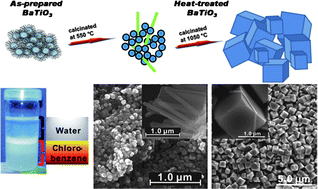Low-temperature synthesis of crystalline BaTiO3nanoparticles by one-step “organosol”-precipitation
Abstract
The “organosol”

* Corresponding authors
a
Institute for Materials Science, University Duisburg-Essen, Universitätsstrasse 15, D-45141 Essen, Germany
E-mail:
doru.lupascu@uni-due.de
Fax: +49 (0)201 183 3968
Tel: +49 (0)201 183 2689
b
Fakultät für Physik and Center for Nanointegration Duisburg-Essen. (CeNIDE), Universität Duisburg-Essen, D-47048 Duisburg, Germany
E-mail:
anna.elsukova@uni-due.de
Tel: +49 (0)203 3792383
The “organosol”

 Please wait while we load your content...
Something went wrong. Try again?
Please wait while we load your content...
Something went wrong. Try again?
Y. Gao, V. V. Shvartsman, A. Elsukova and D. C. Lupascu, J. Mater. Chem., 2012, 22, 17573 DOI: 10.1039/C2JM33373B
To request permission to reproduce material from this article, please go to the Copyright Clearance Center request page.
If you are an author contributing to an RSC publication, you do not need to request permission provided correct acknowledgement is given.
If you are the author of this article, you do not need to request permission to reproduce figures and diagrams provided correct acknowledgement is given. If you want to reproduce the whole article in a third-party publication (excluding your thesis/dissertation for which permission is not required) please go to the Copyright Clearance Center request page.
Read more about how to correctly acknowledge RSC content.
 Fetching data from CrossRef.
Fetching data from CrossRef.
This may take some time to load.
Loading related content
